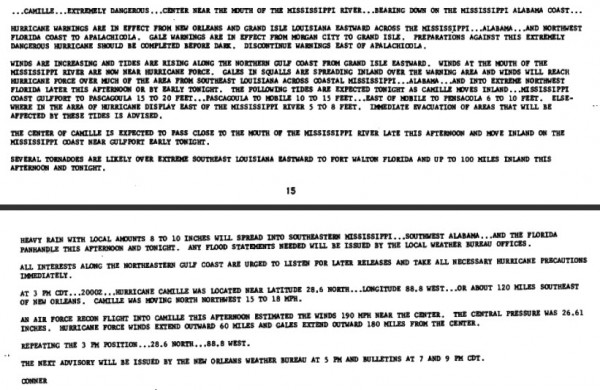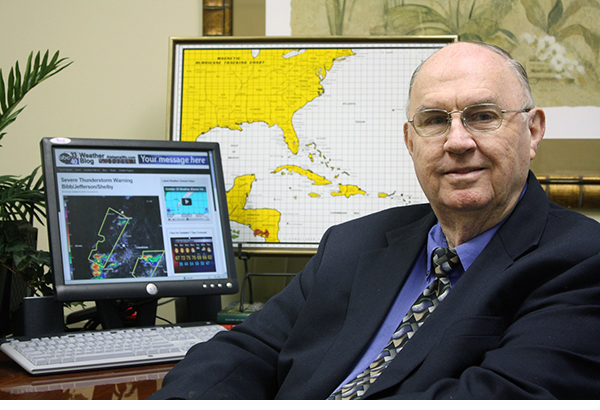Remembering Camille
I remember this date 44 years ago very vividly. It is one of my, if not my earliest weather memories. Hurricane Camille was a monster in the Gulf of Mexico. We had no Weather Channel, no internet, not even Weatheradio to track the storm’s progress. News came in little bits and pieces via radio and television. You knew it was going to be bad, but no one knew how bad it would be. As we drove to church that Sunday, I remember hearing one of those news reports on the radio. There was a deep upper trough over Arkansas and a surface low over western Illinois. In Birmingham, it was cloudy and muggy that morning. At 6 a.m., it was 75F with a humid 72F dewpoint. Our winds were calm, and the barometer was actually rising. Along the coast, it was a different story, as barometers were starting to drop like a rock.
Camille was actually a very small storm, with hurricane force winds that morning only extending out 40 miles in three quadrants, and 60 miles in the stronger northeast quadrant. Early that morning, winds at Mobile were blowing out of the northeast at only 10 mph. But near the center, maximum winds were already 160 mph and they were increasing. By mid-afternoon, a critical Air Force mission would find a pressure of 905 millibars and 190 mph winds. Camille would make landfall on the Mississippi Coast before midnight that August 17th night in 1969. The devastation was incredible.
A couple of years ago, Ken Harness supplied this account about Hurricane Camille:
Forty-three years is a long time, I hope that I can remember enough of my experience of before, during, and after the storm. I remember waking up early on the morning of the 16th of Aug. to the T.V. on in the living room. I went into the room, and my dad was sitting on the couch leaning over a paper hurricane tracking map that was on the coffee table. He had been tracking the storm for a few days, and was watching Nash Roberts on WWL out of New Orleans. Nash gave a set of coordinates and my dad plotted them on the map dropped his pencil and said “it’s coming right down our throats”.
This began our plan of action, we went to a lumber yard and got some ply wood to board up the windows with and a large roll of heavy plastic ( they didn’t sell tarps like we use today). We had the tarp and a staple gun just in case the roof came off. We had moved to Biloxi two weeks after Hurricane Betsy in 1965, so we did not know what to actually expect during a storm like this. After getting non-perishable food and gas in both vehicles, we bought a generator and a couple of gas cans. We also had some large metal awnings around the house so my dad had the idea to try concrete blocks to them to try and hold them down. It didn’t work on all of them some tore off and flew across the top of the house into neighbors yards. We also got a chain saw as we had seven large Southern pines in the front yard along with a 100+ year old Oak tree.
As we settled in for what was to come, my dad said that he had decided that we would go to the shelter at the element school and as we got there he told us the he was going back home to ride out the storm with the dog and to try and take care of the house. Then the “fun” began. I witnessed a tornado traveling down the main road exploding transformers as it went, all types of items flying through the air on the 200 mph winds and the next day saw destruction like I had never seen before. Luckily our house survived, but we spent the next 10 days without power, or running water. The sight of several feet of sand on Hwy. 90 and the two banana cargo ships washed ashore are forever etched in my memory.
My mother still lives in the same house, and has witnessed every storm since including Katrina. She will tell you that it never gets any easier to “ride one out”, but she will never leave her beloved Miss. Gulf Coast.
Thanks Ken!
Category: Met 101/Weather History
















